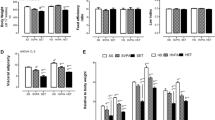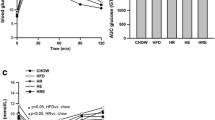Abstract
In addition to acting in the central nervous system, leptin also acts on peripheral tissues such as liver to provide a protection against lipid accretion. Previous evidence from human and animal model indicates that exercise training reduces circulating leptin levels beyond the changes in adiposity levels. Because liver is one of the main peripheral organs for leptin action, this present study was designed to determine whether leptin receptors expression in liver is changed by exercise training. Female rats trained (TR) or kept sedentary (Sed) for 8 weeks were submitted either to a standard (SD) diet for 8 weeks or for 6 weeks followed by 2 weeks of high-fat (HF) or high-carbohydrate (HC) feeding. Food intake, adiposity levels, circulating plasma leptin and insulin concentrations along with the hepatic expression of leptin receptors (ObR-a, -b, and -e) and peroxisome proliferator-activated receptor α (PPARα) and peroxisome proliferator-activated receptor-gamma co-activator-1α (PGC-1α), were measured in all the animals. Intra-abdominal fat depots were increased under the HF but not under the HC diet. As expected, exercise training decreases intra-abdominal adiposity in animals fed with the SD and the HF diet, and to a lesser extent in HC-fed rats. Plasma leptin levels either expressed in absolute values or in values relative to adiposity levels were significantly (P < 0.05) increased with the HF diet and significantly decreased in TR animals, independently of the diet. Moreover, a significant (P < 0.01) reduction in hepatic gene expression of ObR-a, -b and -e was found in TR animals in all the three diet conditions. PPARα and PGC-1α mRNAs were also decreased (P < 0.05) in TR animals in two out of three diet conditions. The present findings indicate that exercise training-induced decrease in plasma leptin levels is accompanied by a reduction in gene expression of three different isoforms of leptin receptors in liver.




Similar content being viewed by others
References
Bornstein SR, Abu-Asab M, Glasow A, Päth G, Hauner H, Tsokos M, Chrousos G, Scherbaum WA (2000) Immunohistochemical and ultrastructural localization of leptin and leptin receptor in human white adipose tissue and differentiating human adipose cells in primary culture. Diabetes 49:532–538. doi:10.2337/diabetes.49.4.532
Shirai Y, Yaku S, Suzuki M (2004) Metabolic regulation of leptin production in adipocytes: a role of fatty acid synthesis intermediates. J Nutr Biochem 15:651–656. doi:10.1016/j.jnutbio.2004.10.002
Cohen P, Miyazaki M, Socci ND, Hagge-Greenberg A, Liedtke W, Soukas AA, Sharma R, Hudgins LC, Ntambi JM, Friedman JM (2002) Role for stearoyl-CoA desaturase-1 in leptin-mediated weight loss. Science 297:240–243. doi:10.1126/science.1071527
Cohen P, Yang G, Yu X, Soukas AA, Wolfish CS, Friedman JM, Li C (2005) Induction of leptin receptor expression in the liver by leptin and food deprivation. J Biol Chem 280:10034–10039. doi:10.1074/jbc.M413684200
Unger RH (2003) The physiology of cellular liporegulation. Annu Rev Physiol 65:333–347. doi:10.1146/annurev.physiol.65.092101.142622
Muoio DM, Dohm GL, Fiedorek FT, Tapscott EB, Coleman RA (1997) Leptin directly alters lipid portioning in skeletal muscle. Diabetes 46:1360–1363. doi:10.2337/diabetes.46.8.1360
Guerra B, Santana A, Fuentes T, Delagdo-Guerra S, Cabrera-Socorro A, Dorado C, Calbet JA (2007) Leptin receptors in human skeletal muscle. J Appl Physiol 102:1786–1792. doi:10.1152/japplphysiol.01313.2006
Ge D, Gooljar SB, Kyriakou T, Collins LJ, Swaminathan R, Snider H, Spector TD, O’Dell SD (2008) Association of common JAK2 variants with body fat, insulin sensitivity and lipid profile. Obesity (Silver Spring) 16:492–496. doi:10.1038/oby.2007.79
Zastrow O, Seidel B, Kiess W, Thiery J, Keller E, Böttner A, Kratzsch J (2003) The soluble leptin receptor is crucial for leptin action: evidence from clinical and experimental data. Int J Obes 27:1472–1478. doi:10.1038/sj.ijo.0802432
Gauthier MS, Couturier K, Charbonneau A, Lavoie JM (2004) Effects of introducing physical training in the course of a 16-week high-fat diet regimen on hepatic steatosis, adipose tissue fat accumulation, and plasma lipid profile. Int J Obes Relat Metab Disord 28:1064–1071. doi:10.1038/sj.ijo.0802628
Hickey MS, Houmard JA, Considine RV, Tyndall GL, Midgette JB, Gavignan KE, Weidner ML, McCammon MR, Israel RG, Caro JF (1997) Gender-dependent effects of exercise training on serum leptin levels in humans. Am J Physiol 272:E562–E566
Fernandez-Galaz C, Fernandez-Agullo T, Campoy F, Arribas C, Gallardo N, Andres A, Ros M, Carrascosa JM (2002) Long-term food restriction prevents ageing-associated central leptin resistance in wistar rats. Diabetologia 45:997–1003. doi:10.1007/s00125-002-0851-4
Miyazaki M, Dobrzyn A, Man WC, Chu K, Sampath H, Kim HJ, Ntambi JM (2004) Stearoyl-CoA desaturase 1 gene expression is necessary for fructose-mediated induction of lipogenic gene expression by sterol regulatory element-binding protein-1c-dependent and -independent mechanisms. J Biol Chem 279:25164–25171. doi:10.1074/jbc.M402781200
Gauthier MS, Favier R, Lavoie J-M (2006) Time course of the development of non-alcoholic hepatic steatosis in response to high-fat diet-induced obesity in rats. Br J Nutr 95:273–281. doi:10.1079/BJN20051635
Schaible TF, Scheuer J (1985) Cardiac adaptations to chronic exercise. Prog Cardiovasc Dis 27:234–297. doi:10.1016/S0033-0620(85)80001-3
Hoffman-Goetz L, MacDonald MA (1983) Effect of treadmill exercise on food intake and body weight in lean and obese rats. Physiol Behav 31:343–346. doi:10.1016/0031-9384(83)90199-3
Bedford TG, Tipton CM, Wilson NC, Oppliger RA, Gisolfi CV (1979) Maximum oxygen consumption of rats and its changes with various experimental procedures. J Appl Physiol 47:1278–1283
Krotkiewski M, Bjorntorp P (1976) The effect of progesterone and of insulin administration on regional adipose tissue cellularity in the rat. Acta Physiol Scand 96:122–127
Ailhaud G (2006) Adipose tissue as a secretory organ: from adipogenesis to the metabolic syndrome. C R Biol 329:570–577. doi:10.1016/j.crvi.2005.12.012
Pellizzon M, Buison A, Ordiz F Jr, Santa Ana L, Jen KL (2002) Effects of dietary fatty acids and exercise on body-weight regulation and metabolism in rats. Obes Res 10:947–955. doi:10.1038/oby.2002.129
Finck BN, Gropler MC, Chen Z, Leone TC, Croce MA, Harris TE, Lawrence JC, Kelly DP (2006) Lipin is an inducible amplifier of the hepatic PGC-1alpha/PPARalpha regulatory pathway. Cell Metab 4:199–210. doi:10.1016/j.cmet.2006.08.005
Saltin B, Astrand PO (1993) Free fatty acids and exercise. Am J Clin Nutr 57:752S–758S
Rector RS, Thyfault JP, Morris RT, Laye MJ, Borengasser SJ, Booth FW, Ibdah JA (2008) Daily exercise increases hepatic fatty acid oxidation and prevents steatosis in Otsuka Long-Evans Tokushima Fatty (OLETF) rats. Am J Physiol Gastrointest Liver Physiol 294:G619–G626. doi:10.1152/ajpgi.00428.2007
Biddinger SB, Miyazaki M, Boucher J, Ntambi JM, Khan CR (2006) Leptin suppresses stearoyl-CoA desaturase 1 by mechanisms independent of insulin and sterol regulatory element binding protein-1c. Diabetes 55:2032–2041. doi:10.2337/db05-0742
Ntambi JM, Miyzaki M (2004) Regulation of stearoyl-CoA desaturases and role in metabolism. Prog Lipid Res 43:91–104. doi:10.1016/S0163-7827(03)00039-0
Cohen P, Zhao C, Cai X, Montez JM, Rohani SC, Feinstein P, Monbaerts P, Friedman JM (2001) Selective deletion of leptin receptor in neurons leads to obesity. J Clin Invest 108:113–1121
Lee Y, Wang MY, Kakuma T, Wang ZW, Babcock E, McCorkle K, Higa M, Zhou YT, Unger RH (2001) Liporegulation in diet-induced obesity. The antisteatotic role of hyperleptinemia. J Biol Chem 276:5629–5635. doi:10.1074/jbc.M008553200
Patterson CM, Levin BE (2008) Role of exercise in the central regulation of energy homeostasis and in the prevention of obesity. Neuroendocrinology 87:65–70. doi:10.1159/000100982
Javor ED, Ghany MG, Cochran EK, Oral EA, DePaoli AM, Premkumar A, Kleiner DE, Gorden P (2005) Leptin reverses nonalcoholic steatohepatitis in patients with severe lipodystrophy. Hepatology 41:753–760. doi:10.1002/hep.20672
Levin BE, Dunn-Meynell AA (2006) Differential effects of exercise on body weight gain and adiposity in obesity-prone and -resistant rats. Int J Obes 30:722–727. doi:10.1038/sj.ijo.0803192
Cohen SE, Kokkotou E, Biddinger SB, Kondo T, Gebhardt R, Kratzsch J, Mantzoros CS, Kahn CR (2007) High circulating leptin receptors with normal leptin sensitivity in liver-specific insulin receptor knock-out (LIRKO) mice. J Biol Chem 282:23672–23678. doi:10.1074/jbc.M704053200
Acknowledgements
This research was supported by the Natural Sciences and Engineering Research Council of Canada (to JM Lavoie), and the Canadian Institutes of Health Research (T 0602145.02 to JM Lavoie and D. Prud’homme, and MOP-53217, MOP-62901 to J. Gutkowska and M. Jankowski).
Author information
Authors and Affiliations
Corresponding author
Rights and permissions
About this article
Cite this article
Yasari, S., Wang, D., Prud’homme, D. et al. Exercise training decreases plasma leptin levels and the expression of hepatic leptin receptor-a, -b, and, -e in rats. Mol Cell Biochem 324, 13–20 (2009). https://doi.org/10.1007/s11010-008-9979-y
Received:
Accepted:
Published:
Issue Date:
DOI: https://doi.org/10.1007/s11010-008-9979-y




